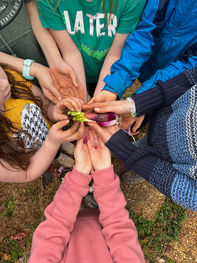
Now Enrolling
2025-26
The Elementary Years
Childhood First, Academics When They’re Ready
In Waldorf education, formal schooling begins in a child’s seventh spring—around the age of six turning seven. Before this time, children learn best through imitation, play, rhythm, and movement. Their early years are devoted to building strong foundations of health, imagination, and social connection. By waiting until they are truly ready, we honor the natural rhythms of childhood and help children step joyfully into learning.
Learning in Harmony with Development
As children enter the elementary years, they are newly ready for more structured academic work—reading, writing, mathematics, and cultural studies. Because their brains and bodies are now developmentally prepared, lessons can be both challenging and joyful, rooted in stories, art, and hands-on experiences that bring concepts to life.
Whole-Child Education
The elementary program balances intellectual growth with artistic expression, movement, and time in nature. Children learn not only to read and calculate, but also to paint, sing, garden, and explore the world around them. This whole-child approach ensures that academics are woven into a rich tapestry of imagination, creativity, and curiosity.
Building Confidence and Wonder
By the time formal academics begin, students are eager and confident learners. They see school as a place of wonder and belonging, where each subject is an adventure. Rather than rushing childhood, we believe in giving children the gift of readiness—so that when academics begin, learning feels both natural and joyful.
Middle School
Development
Did you know your adolescent’s brain reaches its largest size during these years—yet continues rewiring deep into the twenties? This is what makes middle school such an extraordinary developmental phase. Abstract thinking and creativity blossom even as impulse control is still catching up. As researchers explain, the adolescent brain is in the midst of “a fundamental reorganization”—with the emotional reward centers maturing earlier than the judgment-focused prefrontal cortex, which supports planning and self-regulation
Relationships
Peer connections are essential to adolescents’ emotional and academic growth. Studies show that high-quality friendships buffer stress and reduce risk-taking tendencies. And research confirms that supportive peer relationships foster motivation and engagement, which in turn boost academic achievement among middle schoolers. At Flora & Fauna, our 1:4 adult-to-student ratio ensures every student feels seen and supported in a community that values belonging.
Academics
Our middle school curriculum champions hands-on, challenging academics that encourage intellectual risk-taking. Adolescents at this stage are uniquely capable of abstract reasoning, perspective-shifting, and creative problem-solving—making it an ideal time to foster independent, inquiry-based learning. We nurture this potential by designing learning that values curiosity and treats mistakes as a natural part of growth.
Community of Learners
Middle schoolers thrive in environments rich with collaboration, conversation, and shared creativity. Adolescents build empathy, resilience, and identity through strong peer bonds—qualities that are fundamental to both academic and personal success













